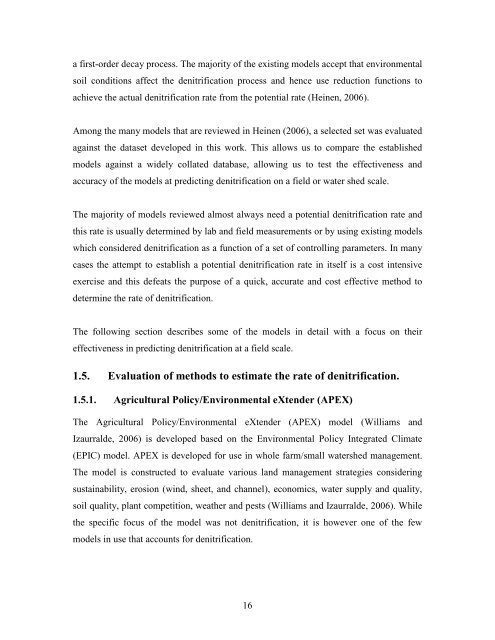THE FLORIDA STATE UNIVERSITY ARTS AND SCIENCES ...
THE FLORIDA STATE UNIVERSITY ARTS AND SCIENCES ...
THE FLORIDA STATE UNIVERSITY ARTS AND SCIENCES ...
You also want an ePaper? Increase the reach of your titles
YUMPU automatically turns print PDFs into web optimized ePapers that Google loves.
a first-order decay process. The majority of the existing models accept that environmental<br />
soil conditions affect the denitrification process and hence use reduction functions to<br />
achieve the actual denitrification rate from the potential rate (Heinen, 2006).<br />
Among the many models that are reviewed in Heinen (2006), a selected set was evaluated<br />
against the dataset developed in this work. This allows us to compare the established<br />
models against a widely collated database, allowing us to test the effectiveness and<br />
accuracy of the models at predicting denitrification on a field or water shed scale.<br />
The majority of models reviewed almost always need a potential denitrification rate and<br />
this rate is usually determined by lab and field measurements or by using existing models<br />
which considered denitrification as a function of a set of controlling parameters. In many<br />
cases the attempt to establish a potential denitrification rate in itself is a cost intensive<br />
exercise and this defeats the purpose of a quick, accurate and cost effective method to<br />
determine the rate of denitrification.<br />
The following section describes some of the models in detail with a focus on their<br />
effectiveness in predicting denitrification at a field scale.<br />
1.5. Evaluation of methods to estimate the rate of denitrification.<br />
1.5.1. Agricultural Policy/Environmental eXtender (APEX)<br />
The Agricultural Policy/Environmental eXtender (APEX) model (Williams and<br />
Izaurralde, 2006) is developed based on the Environmental Policy Integrated Climate<br />
(EPIC) model. APEX is developed for use in whole farm/small watershed management.<br />
The model is constructed to evaluate various land management strategies considering<br />
sustainability, erosion (wind, sheet, and channel), economics, water supply and quality,<br />
soil quality, plant competition, weather and pests (Williams and Izaurralde, 2006). While<br />
the specific focus of the model was not denitrification, it is however one of the few<br />
models in use that accounts for denitrification.<br />
16
















